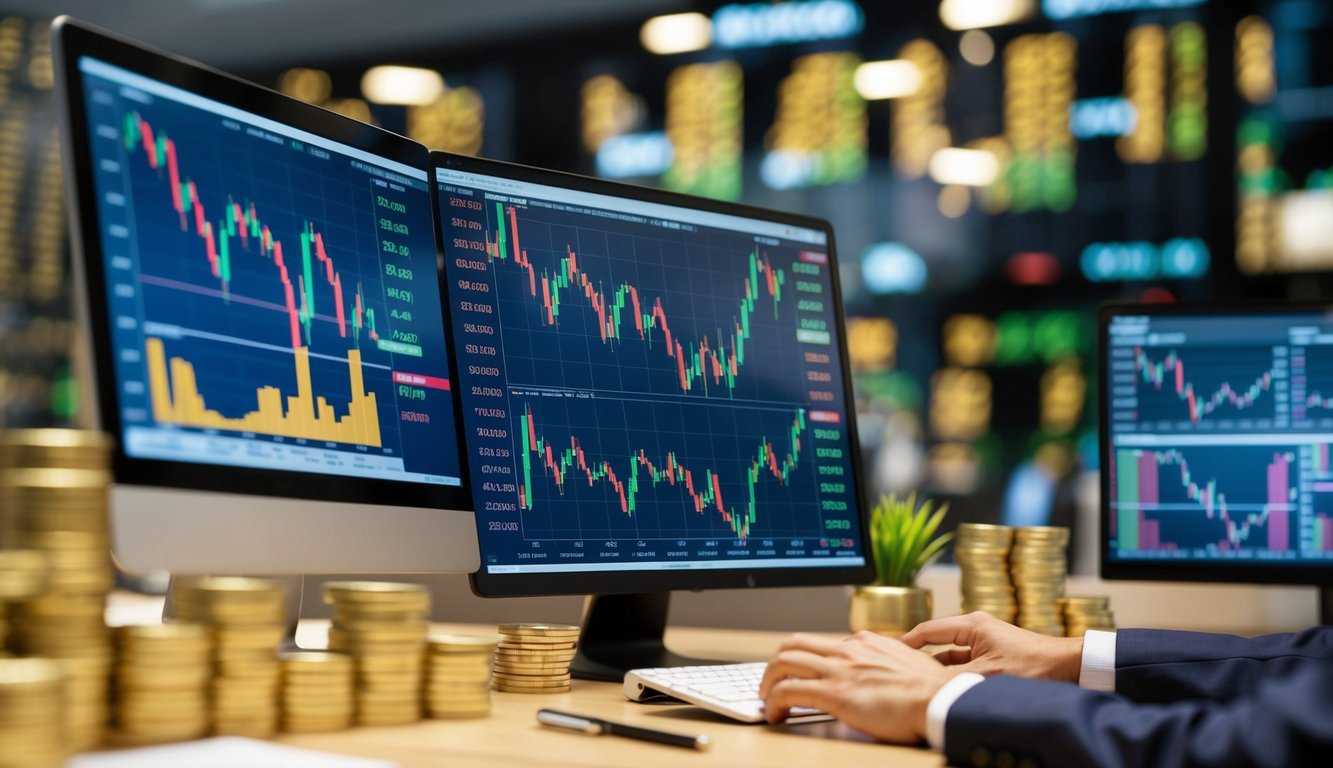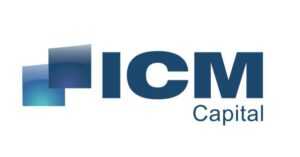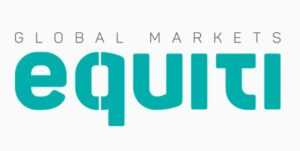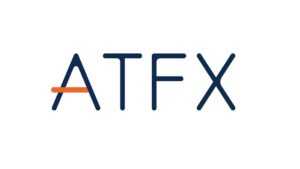Gold trading and investing offer exciting opportunities for those looking to diversify their portfolios. With the rise of online platforms, it’s easier than ever to get started.
Learning effective strategies can help you make informed decisions and potentially increase your returns when trading or investing in gold.

Online gold trading lets you buy and sell gold without physically owning it. This can be done through various methods like futures contracts, ETFs, or trading gold-backed currencies.
Investing in gold, on the other hand, often involves buying physical gold or shares in gold mining companies for long-term gains.
We’ll explore different approaches to gold trading and investing. From technical analysis to fundamental research, there are many ways to make smart choices in the gold market.
We’ll also look at how to manage risks and choose the right investment vehicles for your goals.
Key Takeaways
- Online platforms make gold trading and investing accessible to more people
- Various strategies can help improve decision-making in gold markets
- Proper risk management is crucial for success in gold trading and investing
Fundamentals of Gold Investment

Gold plays a vital role in many investment portfolios. It offers unique benefits that can help balance risks and potentially boost returns.
Understanding Gold as an Investment
Gold is often seen as a store of value and safe haven asset. It tends to hold its worth over time, even when other investments struggle.
Many investors turn to gold during times of economic uncertainty or market turmoil.
Gold can act as a hedge against inflation. As the cost of living rises, gold often maintains its purchasing power. This makes it attractive for preserving wealth long-term.
We can invest in gold through:
- Physical gold (coins, bars)
- Gold ETFs
- Gold mining stocks
- Gold futures contracts
Each option has its own pros and cons. Physical gold offers direct ownership but can be costly to store and insure. ETFs provide easy trading but come with fees.
The Role of Gold in Portfolio Diversification
Adding gold to an investment mix can help spread risk. Gold often moves differently from stocks and bonds, providing balance.
A small gold allocation may:
- Reduce overall portfolio volatility
- Offer protection during market downturns
- Improve long-term risk-adjusted returns
We typically see investors hold 5-10% of their portfolio in gold. The right amount depends on individual goals and risk tolerance.
Gold can shine when other assets struggle. During the 2008 financial crisis, gold prices rose while stocks fell sharply. This highlights its potential as a haven asset in tough times.
⇒ Open your account now with ICM Capital and trade Live on Gold with a global multi-regulated broker and authorized by the Abu Dhabi Global Markets (ADGM) ⇐
Gold Market Analysis Techniques

Analyzing gold markets requires a mix of technical and fundamental approaches. We’ll explore key methods for evaluating gold price movements and making informed trading decisions.
Technical Analysis and Indicators
Technical analysis helps us spot patterns in gold prices. We use charts to track price trends over time.
Moving averages smooth out price data to show overall direction. The 50-day and 200-day moving averages are popular choices.
Indicators like the Relative Strength Index (RSI) measure momentum. An RSI above 70 suggests gold may be overbought. Below 30 hints it could be oversold.
Support and resistance levels are price points where gold often bounces or struggles to break through. We watch these levels to predict potential reversals or breakouts.
Fundamental Analysis of Gold Markets
Fundamental analysis looks at factors that affect gold’s value. Supply and demand play a big role.
We track gold production from mines and recycling. On the demand side, jewelry, technology, and investment buying are key.
Central bank policies impact gold prices too. When banks print more money, it can boost gold as a safe haven. Interest rates also matter – lower rates often help gold prices rise.
Geopolitical events can spark gold rallies. Wars, trade disputes, and elections can push investors towards gold’s perceived safety.
⇒ Open your account now with ICM Capital and trade Live on Gold with a global broker who holds international licenses and is authorized by the Abu Dhabi Global Market UAE
⇒ Open your account now with Equiti and trade Live on Gold with a global broker who holds international licenses and is authorized by Securities and Commodities Authority of the UAE.
Economic Indicators and Their Impact
Several economic reports influence gold prices. Inflation data is crucial – higher inflation tends to support gold as a store of value. We watch Consumer Price Index (CPI) releases closely.
Employment numbers affect gold too. Strong job reports can lead to higher interest rates, which may pressure gold prices. Weak reports might do the opposite.
GDP growth rates impact gold indirectly. Slow growth can lead to looser monetary policies, potentially helping gold. Fast growth might lead to tighter policies, which could hurt gold prices.
Strategies for Trading Gold Online

Gold trading offers various approaches for investors to profit from price movements. Different strategies suit different goals and market conditions.
Day Trading and Scalping Strategies
Day trading gold involves buying and selling within a single day. We look for small price changes to make quick profits.
Scalping takes this further, aiming for even faster trades.
Key tools for day trading include:
- Price charts
- Technical indicators
- Economic calendars
We watch for breaking news that might affect gold prices. Interest rate changes often impact gold values. Quick decision-making is crucial.
Scalpers may use 1-minute or 5-minute charts. They aim for many small gains throughout the day. This needs fast execution and low trading costs.
Swing Trading and Range Trading
Swing trading catches larger price moves over days or weeks. We look for trends and try to ride them. Technical analysis helps spot potential entry and exit points.
Range trading works when gold prices move sideways. We buy at the bottom of the range and sell at the top. This repeats until the range breaks.
Useful indicators for these strategies:
- Moving averages
- Bollinger Bands
- Relative Strength Index (RSI)
News events can create good swing trading chances. Major economic reports often cause gold to break out of ranges.
Long-Term Gold Investment Strategies
Long-term gold investing focuses on holding positions for months or years.
We look at big-picture trends in the economy and markets.
Factors to consider:
- Inflation rates
- Interest rate
- Currency strength
- Global political events
Dollar-cost averaging can work well. This means buying a set amount of gold regularly, regardless of price. It smooths out market ups and downs.
Some investors use gold as a hedge against economic uncertainty. In this case, we might increase gold holdings when other markets look shaky.
ETFs and gold mining stocks offer ways to invest without owning physical gold. These can be part of a diversified long-term strategy.
- Open your account now with ICM Capital and trade Live on Gold with a global broker who holds international licenses and authorized by the Abu Dhabi Global Market UAE.
- Open your account now with Equiti and trade Live on Gold with a global broker who holds international licenses and authorized by Securities and Commodities Authority of the UAE.
Managing Risks in Gold Trading and Investment
Gold trading and investing can be profitable, but it comes with risks. We need to use smart strategies to protect our money and increase our chances of success.
Risk Management Fundamentals
Risk management is key in gold trading. We should only risk a small part of our account on each trade, usually 1-2%. This helps us avoid big losses if a trade goes wrong.
We also need to understand what affects gold prices. Things like inflation, currency values, and global events can all move the market. Staying informed helps us make better choices.
It’s important to have a solid plan before we start trading. We should set clear goals and know our risk tolerance. This keeps us from making rash decisions based on emotions.
Leverage and Its Risks
Leverage lets us control more gold with less money. But it’s a double-edged sword. While it can boost profits, it also increases potential losses.
We need to use leverage wisely. Starting with lower leverage, like 1:5 or 1:10, is safer for beginners. As we gain experience, we can adjust our approach.
It’s crucial to understand how leverage affects our trades. A small market move can have a big impact on our account. We must always be aware of our total exposure.
Open your account now with ICM Capital and trade Live on Gold with a global broker who holds international licenses and authorized by the Abu Dhabi Global Market UAE. Similarly, you can open your account now with Equiti and trade Live on Gold with a global broker who holds international licenses and authorized by Securities and Commodities Authority of the UAE.
Using Stop-Loss Orders and Position Sizing
Stop-loss orders are a must for managing risk. They automatically close our trade if the price hits a certain level. This limits our losses if the market moves against us.
We should set our stop-loss as soon as we enter a trade. A good rule is to risk no more than 1-2% of our account on any single trade.
Position sizing is just as important. We need to calculate the right amount of gold to trade based on our account size and risk tolerance. This helps us stay in the game even if we have a string of losses.
Gold Investment
Gold investing offers several options for adding this precious metal to your portfolio. Each method has unique characteristics that can suit different investor needs and goals.
Pros and Cons of Physical Gold
Physical gold gives us direct ownership of a tangible asset. We can buy gold bars or coins from dealers. It’s a way to hold real wealth outside the financial system.
Pros:
- Full control over our investment
- Can be stored at home or in secure vaults
- May offer privacy
Cons:
- Storage costs and security concerns
- No income generation
- Can be difficult to sell quickly
Physical gold requires careful handling and secure storage. We need to consider insurance and the risks of theft or loss.
“Open your account now with ICM Capital and trade Live on Gold with a global broker who holds international licenses and authorized by the Abu Dhabi Global Market UAE.”
“Open your account now with Equiti and trade Live on Gold with a global broker who holds international licenses and authorized by the Securities and Commodities Authority of the UAE.”
Gold ETFs and Mutual Funds
These funds offer an easier way to invest in gold without owning it physically. They track gold prices and trade on stock exchanges.
Popular options include:
- SPDR Gold Shares (GLD)
- iShares Gold Trust (IAU)
Benefits:
- Easy to buy and sell
- Lower storage costs
- Professional management
Drawbacks:
- Annual fees
- No physical gold ownership
- Dependent on fund performance
ETFs and mutual funds can be a good choice for investors who want gold exposure without the hassle of physical storage.
Gold Futures and Their Mechanics
Gold futures are contracts to buy or sell gold at a set price on a future date. They’re traded on commodities exchanges.
Key points:
- Require a smaller initial investment
- Allow for leverage
- Can be used for hedging
Risks:
- High volatility
- Potential for significant losses
- Complex for beginners
Futures contracts can be a powerful tool for experienced traders. They offer the potential for big gains but also come with big risks. We need to understand the mechanics well before trading futures.
⇒ Open your account now with ICM Capital and trade Live on Gold with a global multi-regulated broker and authorized by the Abu Dhabi Global Markets (ADGM) ⇐
Frequently Asked Questions
Gold trading and investing can be complex. These questions cover key strategies, best practices, and important considerations for both beginners and experienced traders.
What are the key elements of a profitable gold trading strategy?
A profitable gold trading strategy needs careful planning. We recommend setting clear goals and risk limits.
Staying updated on market news is crucial. Technical analysis tools can help spot trends. It’s also wise to diversify and not put all your money in one trade.
What are the best practices for beginners looking to trade gold online?
New traders should start small and learn as they go. We suggest using demo accounts to practice without risk.
Learning about different gold products is important. Reading market analysis and watching tutorials can help build knowledge. It’s smart to start with simple trades before trying complex strategies.
How do you successfully trade XAUUSD in the Forex market?
Trading XAUUSD needs a good grasp of both gold and currency markets. We find that keeping an eye on economic data helps.
Using stop-loss orders can protect against big losses. It’s useful to understand how gold prices move with dollar strength. Practicing with small trades can build confidence over time.
What is the minimum capital required to start trading gold in Forex?
The minimum needed varies by broker. We’ve seen some allow trading with as little as $100.
But having more capital gives more flexibility. It’s best to start with money you can afford to lose. Remember, leverage can increase both gains and losses.
Which methods are most effective for making money trading gold online?
Effective methods include day trading and swing trading. We’ve found that following trends can work well.
Some traders use options or futures for leverage. Others prefer buying physical gold or ETFs for long-term gains. The best method depends on your goals and risk tolerance.
How can one build a successful strategy for investing in gold over the long term?
Long-term gold investing needs patience. We suggest buying gradually over time to average out prices.
Holding physical gold can be good for stability. Gold ETFs offer an easy way to invest without storing metal.
It’s smart to rebalance your portfolio regularly. Watching global economic trends can help time purchases.








